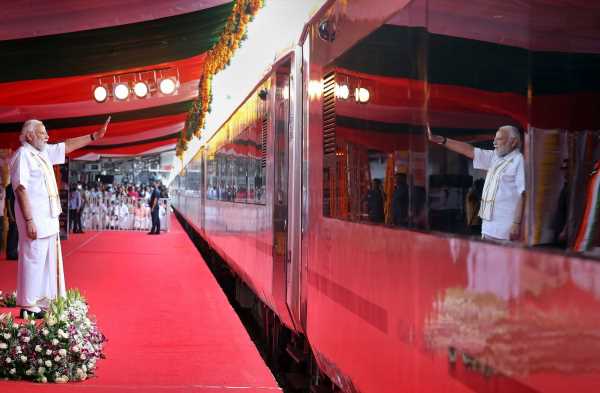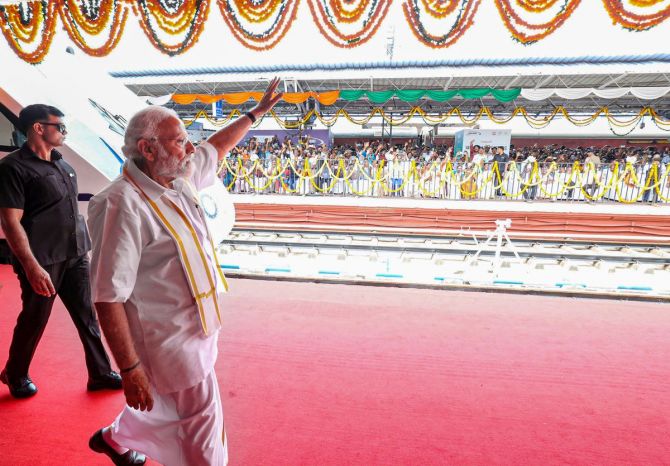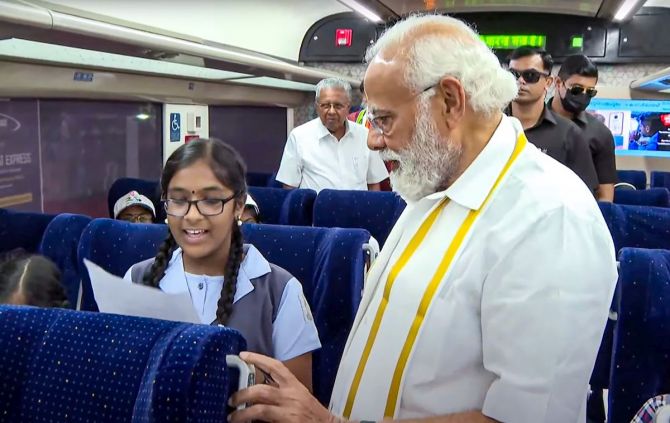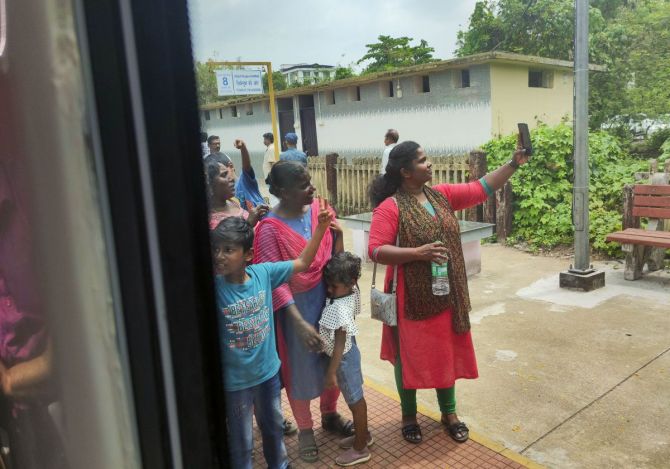Prime ministers turning up with such frequency to launch trains is an indication of the political mileage resident in public transport.
Will our railways step out of the government’s shadow?
After all, they are the ones manufacturing trains and running them, notes Shyam G Menon.
By and large, people in Kerala enjoy a comfortable life. More comfortable than in many parts of India.
With a remittance economy for steroid, spending power is high. Proof may be found in the assets accumulated, a lot of it just for show.
Yet, in land of the well-settled, residents are never short of complaints.
As a relative put it, “We deserve the best.” According to him, getting the state the best of what is on offer should be every elected representative’s job.
Kerala’s chosen bunch for the task, he felt, had failed to deliver. Rail travel to Kerala and within the state, has always been a sore point in this regard.
Kerala is in the extreme south of India. It is a long way from Delhi, Mumbai and Kolkata.
At the same time, Kerala is unique for nearly half of its total population being elsewhere. They are in other parts of India and abroad.
In the past, trains to Kerala were few and securing a ticket used to be a headache.
The number of trains have increased since, but it won’t be wrong to say that both the quality of trains allotted to Kerala and their maintenance have stayed debatable.
My relative was therefore thrilled to hear of the imminent introduction of Kerala’s first Vande Bharat train.
Next morning as I approached the Ernakulam Town station to catch my Jan Shatabdi to Thiruvananthapuram, I saw the hero of the times pull in on its first trial run in Kerala.
Given Vande Bharat made its debut in India in February 2019 and had thereafter graced the railway lines in several states, it — arguably — took its own sweet time to reach Kerala despite the state’s highly mobile population.
But that didn’t seem to matter. There was a clutch of curious onlookers at Ernakulam Town; there was the selfie brigade and there was the politically correct reached in time to behold and welcome Vande Bharat.
In the 1930s, the Third Reich had hoped to convey its vision to the German people by driving in a people’s car (for the record, the Beetle’s peak sales happened after World War II).
As a vehicle for public transport, Vande Bharat is a wholesale phenomenon but unlike the Beetle which touched one or a few every time it was sold, the white and blue train is capable of leaving many with a retail feel of India’s industrial progress and the vision of the central government.
Even if that ‘many’ be drawn from income brackets, which can afford the service.
That’s the impact of improvements in public transport.
The BJP has been very smart in spinning marketable motifs from its initiatives in the infrastructure space.
Evidently, my relative was among those floored and its symptoms amplified deeper into the chat when he supported some of the genuinely contentious views of the political Right-Wing.
Thanks to a new train, a lot else about the political Right-Wing appeared overlooked.
It’s what happens when infrastructure is identified too closely with political parties.
On the one hand, infrastructure becomes an extension of party propaganda.
On the other hand, politics becomes the stuff of technocrat’s view of world; all efficiency, execution and performance with little awareness of the larger values, social justice, inclusiveness, human rights — and above all, love for freedom – that go into sense of democratic country.
Serious ethical deficiencies on the part of government get overlooked because they are giving the people, swanky infrastructure; a chance for society to seem modern without being comprehensively and convincingly so.
The fault isn’t infrastructure’s; the fault lay in the opportunistic spins.
On April 19, 2023, the Financial Express newspaper noted in its report on Kerala’s Vande Bharat train, ‘earlier in the month, the Prime Minister had launched semi-high speed Vande Bharat Express trains on four different routes — Rani Kamlapati-New Delhi, Secunderabad-Tirupati, Chennai-Coimbatore, and Ajmer-Delhi Cantonment.’
Prime ministers turning up with such frequency to launch trains is an indication of the political mileage resident in public transport.
Years ago, Maruti, Sanjay Gandhi and the Congress had seemed one package.
To the credit of the automobile manufacturer and subsequent governments, Maruti stepped out of that shadow.
Will our railways step out of the government’s shadow? After all, they are the ones manufacturing trains and running them.
Hours after I saw the Vande Bharat train in Ernakulam, the halo it inspired began to correct.
The publicity surrounding its introduction in Kerala had included graphs in the media depicting the time taken by existing trains to cover similar distance (Thiruvananthapuram to Kannur) in the state.
Given the curves in Kerala’s railway tracks and its high population density, experts had said that the train won’t run as fast as it does in other states.
The graphs showed the saving in time to be significant and yet, upon reflection, hard to decide how much it actually counted as emblem of a society’s advancement.
As some felt in the case of the SilverLine project mooted earlier by the state’s Left Democratic Front (on April 17, Congress politician K. Muraleedharan said that with Vande Bharat in Kerala, SilverLine should now be abandoned), it makes one question the relevance of speed as sole differentiator in public transport.
Perception is a heterogenous chaos in Kerala.
Like the state’s chai-kadi (tea and snacks) counters rooted in common sense, there are those who assess public transport from the angle of affordability, functional comfort and reasonable time taken to destination.
Then, there are those who identify with experiences and pictures from overseas; people with children and grand children abroad who wish for a Kerala that resembles the tony lands the younger generation visits from.
There are also those sold on the technological marvel modern city states are and who wish to see those standards replicated in Kerala.
For the latter two, Vande Bharat would no doubt be an emblem of state having arrived.
Amidst this, relevance that transcends niche appeal and economic strata typically encompasses making what already exists, more efficient and attractive.
Simply put– maintaining the existing well.
This means, trains that are already running should be looked after properly.
They should be clean, their seats, snack trays and bathrooms should work.
Rolling stock should be good. The very same relative who was excited about Vande Bharat, listed complaints regarding existing trains.
I was thinking of all this as my Jan Shatabdi brought me on time to Thiruvananthapuram.
The picture of the white and blue Vande Bharat was still in mind as I ambled along the platform to the exit.
That was when I noticed the outside of the premium compartment, I had just travelled in.
The paint on it and adjacent others seemed stained or peeled off considerably; probably the aftermath of advertisements removed.
Whatever, it was a shoddy-looking train.
A far cry from the clean white and blue I had seen that morning. It was April 17, 2023.
A day later, news broke that Vande Bharat would run from Thiruvananthapuram to Kasaragod.
Further, the curves in Kerala’s main railway line would be straightened in two phases.
With the train’s flag-off by Prime Minister Narendra Modi on April 25 and Kerala now highlighted as a prized electoral target by the BJP, more excitement around Vande Bharat would be in the pipeline.
There will be more selfies and in the countdown to the polls of 2024, heated political arguments within families.
Shyam G Menon is a Mumbai-based columnist.
Feature Presentation: Aslam Hunani/Rediff.com
Source: Read Full Article




